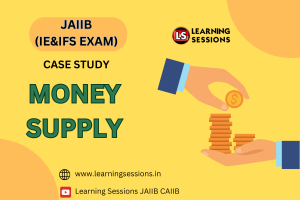The approach of Money Supply plays a primary role in understanding the Indian Economy (IE) and Indian Financial System (IFS). For banking professionals preparing for the JAIIB (Junior Associate of the Indian Institute of Bankers) exam, having an intensive grasp of money supply is important, as it forms the backbone of several economic policies and financial stability. An article by Learning Sessions on case study in which we will explore money supply in India, touching upon key concepts and examining their implications for the Indian economy and financial system.

📚 JAIIB Study Resources 📚
👉 Check Here
👉 Check Here
👉 Check Here
👉 Get Tests Here
👉 Check Here
DOWNLOAD PDF MONEY SUPPLY -CASE STUDY
Money supply refers to the total stock of money available in an economy at a given point of time. Money supply is categorized into different measures of monetary aggregates, such as:
-M1: Currency in circulation + demand deposits with banks.
-M2: M1 + savings deposits with post office savings banks.
-M3: M1 + time deposits with banks (often referred to as “broad money”).
-M4: M3 + total deposits with post office savings banks (excluding National Savings Certificates).
In the context of the Indian financial system, the Reserve Bank of India (RBI) closely monitors and regulates the money supply to ensure economic stability. For the extensive preparation of candidates, get details through our YouTube videos for JAIIB IE & IFS Module wise Syllabus with explanations and tips to help candidates in their preparation journey.
You may also like these JAIIB Case Studies:
JAIIB | IE & IFS | FEMA ACT, 1999
JAIIB | IE & IFS | TREDS
Another critical aspect of money supply management in India is its role in promoting financial addition. By increasing the reach of banking services, particularly to rural and underserved areas, the Pradhan Mantri Jan Dhan Yojana (PMJDY) program contributed to an expansion of the money supply. As more people started using formal financial services, the money circulating in the informal economy was absorbed into the formal financial system. Learning Sessions provides additional information about JAIIB IE & IFS FACTORING by giving examples of real life scenarios.
Considering all this, the progress of money supply in India focuses on the complex relationship between monetary policy, economic growth, inflation, and financial inclusion. For JAIIB applicants, understanding how the RBI controls Money Supply through various tools is necessary for practicing the vast Indian financial system.
Learn more about this case study through our YouTube channel and PDF.
Get access to our Telegram Channel for free Pdfs of JAIIB.







